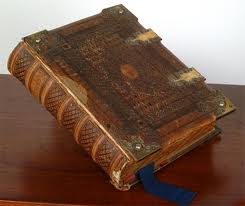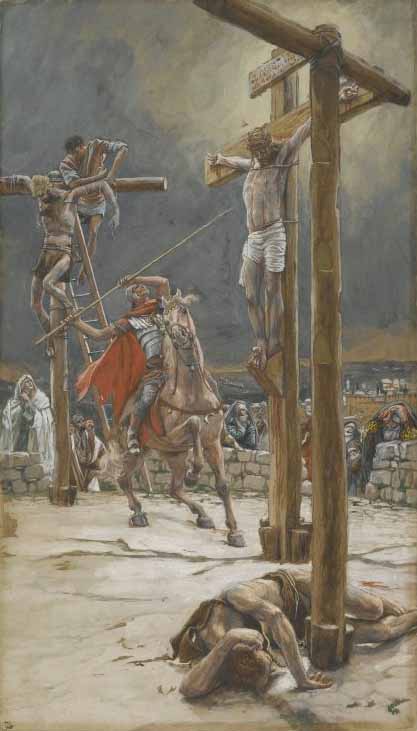
Does Russia have the centurion’s spear that pierced our Savior’s body on the Cross?
Could the Roman lance have survived? Yes, say those who tell a tale that would make a good Indiana Jones plot. The relic said to be the centurion’s spear was highly sought after by Adolf Hitler — who was convinced its power would give him victory.
But it turned up in the hands of legendary U.S. General George S. Patton … who took great delight in having deprived the Fuhrer of his prize.
But is it the real spear?
Such a spear is mentioned only once in the Bible, in the Gospel of John 19:31–37, but not in Matthew, Mark or Luke, nor any of the Epistles. John describes how the Roman soldiers planned to break Jesus’ legs, a practice known as crurifragium, which was a method of hurrying death during a crucifixion.
Just before they did so, however, the soldiers realized that Jesus was already dead and that there was no reason to break his legs. To make sure, however, one of the soldiers stabbed him in the side.
“… one of the soldiers pierced his side with a lance, and immediately there came out blood and water” John 19:34.
That’s history. But is there any way the spear survived the centuries?
Yes, say a group of Armenian monks. They treasure their relic, which is called the Holy Lance, the Spear of Destiny, the Holy Spear, and the Lance of Longinus – and they are certain it is the very lance that pierced Jesus’ side.
Hitler went to a great deal of trouble to find and confiscate the spear. There is even a story that Hitler was winning the war until Patton discovered the spear in an underground bunker in Nuremberg and realized what it is. At that very moment, according to the story, Hitler committed suicide and the U.S. succeeded Germany as the new world power because it now possesses the spear.
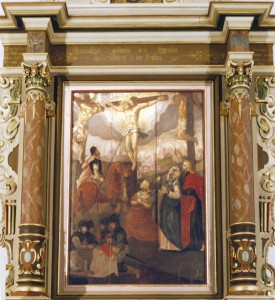
Well, sometimes the facts get in the way of a good story.
Hitler was not winning the war when Patton found the spear. The United States did not keep the relic, but returned it to a museum in Vienna which Hitler had looted.
But is there any truth to Hitler’s belief that this was the “true spear” that pierced Jesus on the Cross?
There are several significant spears in the Bible. One is hurled at young David by King Saul. Another is carried by the giant Goliath. Another is used to kill the Prophet Zachariah between the Altar and the Holy Place. However, the Bible does not provide any details about the spear that pierced our Savior’s side – nor does it name the Roman soldier. Tradition says his name was Longinus.
And it turns out that there are several spearheads today that are reputed to be from the lance mentioned by John.
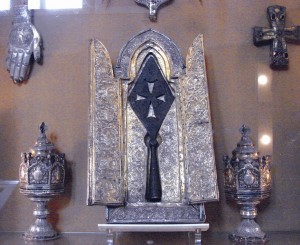
One is on display at a monastery in Etschmiadzin, in a part of Armenia inside today’s Russia. It was allegedly unearthed by a Crusader named Peter Bartholomew in Antioch in 1098 while the Crusaders were under siege from the Seljuk Turks. When things looked darkest for the Christian defenders, Peter had a vision, he proclaimed later, in which St. Andrew told him where the Holy Lance was buried in Antioch.
After much digging, Peter’s Crusaders unearthed the lance, took it a sign from heaven and routed the Turks, capturing Antioch.
Some scholars who have examined this particular relic say is not actually a Roman lance, but could be the head of a Roman standard – used to carry banners – and is not likely to have been used to stab a crucifixion victim.
The Armenian monks discount such doubters. They are certain the spear is authentic.
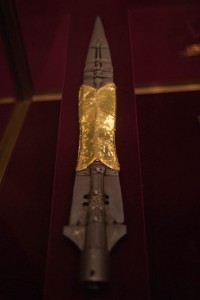
But what about the Vienna lance? Its identical twin has been venerated at Krakow, Poland, since at least the 1200s. However, it is admittedly a copy of the Vienna lance. Austria’s Emperor Henry II had it created with a small sliver of the original lance. Another copy was given to the King of Hungary around the same time.
A third story is told by medieval historian William of Malmesbury, describing a nobleman named Hugh Capet giving the Holy Lance to King Athelstan of England. However, that spear has disappeared.
Yet another spear is in the Vatican. This one is distinctive in that it is broken and has no tip. It was first described around the year 570 A.D. as having been on display in the basilica of Mount Zion in Jerusalem along with what was said to have been the true Crown of Thorns.
The point of that spearhead is alleged to have been snapped following the Persian conquest of Jerusalem in A.D. 615. The point is said to have been framed into an icon, and found its way to the church of Hagia Sophia in Constantinople. It was later transported to France, where it remained in the Church of Sainte Chapelle until the 18th century. The icon was moved to the Bibliotheque Nationale national library in Paris during the French Revolution – but during the chaos of that period disappeared.
The lower section of the spearhead was allegedly conveyed from Jerusalem to Constantinople sometime in the 8th century, sent by Sultan Beyazid II as a gift to Pope Innocent VIII in 1492. The pope had the relic placed in St. Peter’s Basilica where it still resides. The Catholic Church makes no claim as to its authenticity, just to its 1,500-year history.
But, what about that spear in Vienna – the one that General Patton kept away from Hitler?
Sometime back in the centuries, it was broken in two. Wedged between the two pieces is an iron spike that legend says is one of the nails from the Cross. The nail is held in place by silver wire and covered by a silver sleeve, which is in turn covered by a gold sleeve. At the bottom are two pieces of metal that apparently were added in medieval times, giving the spearhead the look of an arrowhead.
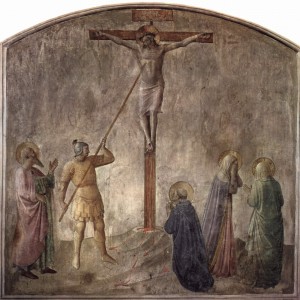
Today the Vienna lance is part of the Crown Jewels of the House of Hapsburg – which include gem-encrusted crowns, rings, necklaces and so forth.
The earliest authenticated reference to the Vienna lance occurs in the writings of Luitprand of Cremona, a bishop and historian. He wrote that it had belonged to a Roman centurian, Longinus, who Luitprand says was the soldier who used it to pierce Christ’s side.
Legend says that Longinus was losing his sight. According to the story, when he fell to his knees after uttering the words, “Surely this was the Son of God,” he had his sight miraculously restored. Various accounts exist of Longinus’s subsequent life. Put simply, he seems to have retired from the Roman army, become a Christian, then died under torture when he refused to recant his faith.
Luitprand wrote that Longinus passed the lance to a fellow Christian, a black Egyptian and Roman commander named Maurice. According to Luitprand, Maurice was commander of a company of soldiers who were sent to put down a rebellion. When he found that the rebels were fellow Christians, Maurice refused to take up arms against them.
For this and refusing to worship a commander’s pagan idols, he was executed, according to Luitprand, who wrote that his spear was eventually presented to the first Christian Roman emperor, Constantine, sometime before 337. Luitprand also wrote that it was owned by Charlemagne, born in 742.
Luitprand wrote all this in 961.
History records that the lance was present at the 1084 coronation of the Holy Roman Emperor Henry IV. He also ordered the silver band that bears the inscription “Nail of Our Lord.” During the 14th century, King Charles IV of Bohemia and Germany proclaimed the spear to be the “Lance of the Lord” and had the golden sleeve put over the silver one, which is inscribed “Lance and Nail of the Lord.”
In 1411 Sigismund was made Holy Roman Emperor. In 1424 he announced: “It is the Will of God that the Imperial Crown, Orb, Scepter, Crosses, Sword and Lance of the Holy Roman Empire must never leave the soil of the Fatherland.” That collection of relics, known collectively as the Reichkleinodien or Imperial Regalia, were moved from his capital in Prague to his birth place, Nuremberg. It made the journey to its new home concealed beneath a wagonload of fish.
In 1438 a silver-embossed chest was made to contain it, and hung for safekeeping from the rafters of the church at the Hospital of the Holy Ghost.
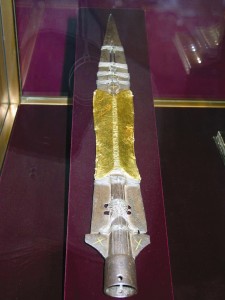
Once a year, along with lesser relics – a sliver of wood from the manger, a tooth of John the Baptist and an arm bone of St. Anne – it was taken down and displayed to pilgrims in the market square. Such was its reputed power that King Ferdinand and Queen Isabella of Spain sent a piece of cloth to be pierced by it, making it a holy relic in its own right. Count Ferdinand of Austria had it dipped into a keg of wine. Pilgrims looked at it through mirrors in the belief that they could capture its image and take it home.
When the army of Napoleon Bonaparte approached Nuremberg in the spring of 1796, many were terrified that Napoleon would seize the spear and rule the world with it. The city councilors decided to remove the collection to Vienna for safe keeping. The relics were entrusted to one Baron von Hagel, who promised to return the objects as soon as peace had been restored and the safety of the collection assured.
However, the Holy Roman Empire was officially dissolved in 1806. Baron von Hugel took advantage of the confusion over who was the legal owner of the Reichkleinodie and sold the entire collection, including the spear, to the Habsburgs. After Napoleon’s defeat at Waterloo, the city councilors of Nuremberg asked for their treasures back. The Austrian authorities’ response was a curt rejection.
In 1912, according to legend, young Adolf Hitler saw the spear in Vienna and recognized it as a talisman of power. In fact, in 1938 when the Nazis seized control of Austria, Hitler had the spear taken back to Germany.
The true extent of Hitler’s involvement with the so-called “Spear of Destiny” is disputed. Did the Nazis covet the spear only as part of their generalized greed? It is well documented that they looted Europe of its art treasures.
Or did Hitler himself have a deeper, specific interest in it, believing it would give him great power?
In 1945 American troops under General Patton recovered the spear and returned it to Vienna.
In 2003, Dr. Robert Feather of England, a metallurgist and technical engineering writer, was allowed to examine the spear. He was given unprecedented access not only to examine it in a laboratory environment, but also was allowed to remove the delicate sheaths of gold and silver that hold its broken pieces together.
On its short journey to the Institute of Sciences and Technologies in Art, in nearby Schillerplatz, it was accompanied by two armed guards and a curator, Dr. Franz Kirchweger.
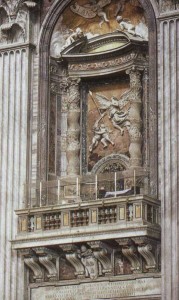
The spear was tested first for any residue of human blood. The results were no surprise to anyone. Two thousand years after the crucifixion, and after innumerable cleanings, the spearhead could hardly be expected to retain traces of blood.
Forensics reveal only a few sloughed skin cells, some minute mineral particles and spores – typical ingredients of house dust.
Next under the microscope was the silver wire that bound the broken pieces together.
If it is truly ancient – earlier, say, than 600 A.D. – then it would be made of thin metal strips that had been hammered flat, then cut and twisted.
However, the wire turns out to have been drawn through a die, giving it a regular round or oval profile – dating it no earlier than 1000 A.D.
The inner, silver sleeve was dated to the 11th century and the outer, gold one from the 14th.
Dr. Feather further concluded that the spear could not be early Roman. It is too big. Pre-Christian Roman spearheads typically are 8 to 10 inches long. This one is 20 inches. In the opinion of Feather and other academic experts, the likeliest date for its manufacture was the 7th century.
However, the “Nail of the Lord” held by the silver wire is iron. It is too small to be genuine, but x-rays showed that some fragments of a genuine crucifixion nail might have been beaten into it.
So, is the relic authentic?
Apparently it is not the spear used to pierce Jesus’ side.
However, Dr. Feather found that the iron pin – long claimed to be a nail from the Crucifixion, hammered into the blade and set off by tiny brass crosses – is “consistent” in length and shape with a 1st century A.D. Roman nail.
The nail could be the real thing.
It could have pierced our Lord’s hand.
Perhaps.

